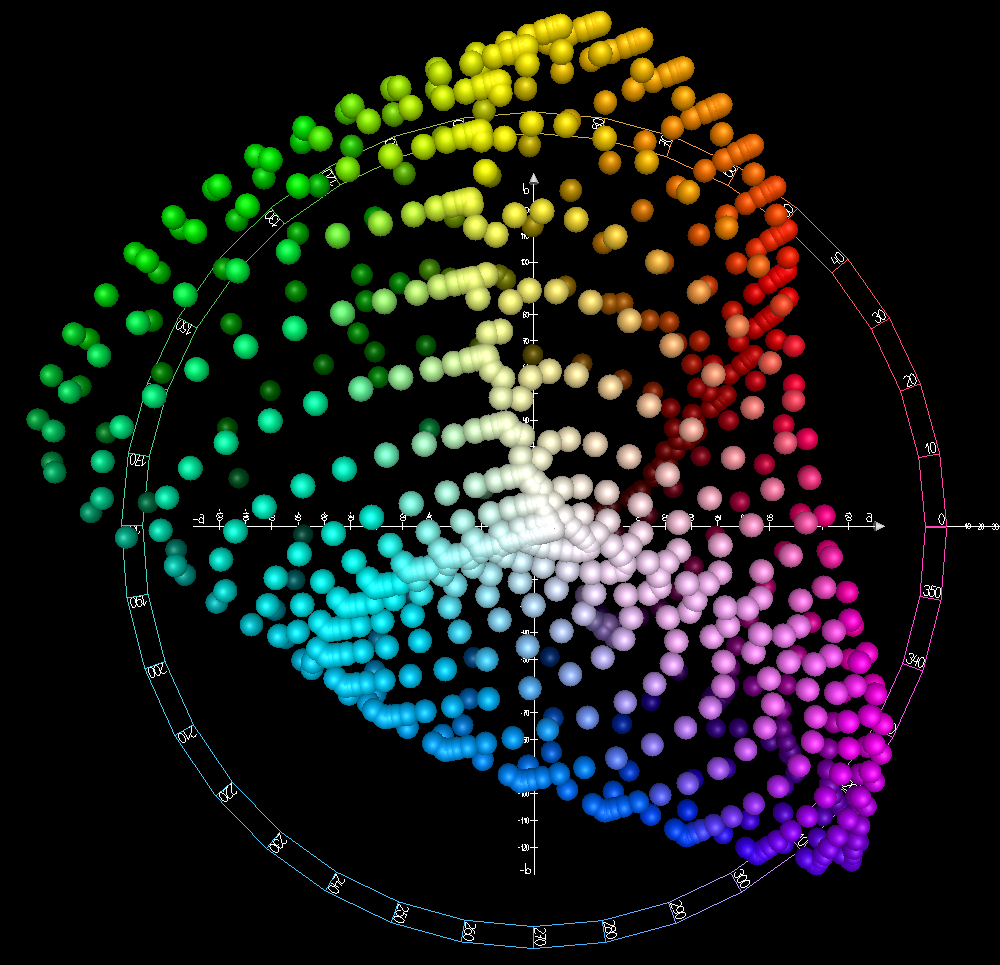|
CIELUV
In colorimetry, the CIE 1976 ''L''*, ''u''*, ''v''* color space, commonly known by its abbreviation CIELUV, is a color space adopted by the International Commission on Illumination (CIE) in 1976, as a simple-to-compute transformation of the 1931 CIE XYZ color space, but which attempted perceptual uniformity. It is extensively used for applications such as computer graphics which deal with colored lights. Although additive mixtures of different colored lights will fall on a line in CIELUV's uniform chromaticity diagram (called the ''CIE 1976 UCS''), such additive mixtures will not, contrary to popular belief, fall along a line in the CIELUV color space unless the mixtures are constant in lightness. Historical background CIELUV is an Adams chromatic valence color space and is an update of the CIE 1964 (''U''*, ''V''*, ''W''*) color space (CIEUVW). The differences include a slightly modified lightness scale and a modified uniform chromaticity scale, in which one of the coordina ... [...More Info...] [...Related Items...] OR: [Wikipedia] [Google] [Baidu] [Amazon] |
CIELAB
The CIELAB color space, also referred to as ''L*a*b*'', is a color space defined by the International Commission on Illumination (abbreviated CIE) in 1976. It expresses color as three values: ''L*'' for perceptual lightness and ''a*'' and ''b*'' for the four Unique hues, unique colors of human vision: red, green, blue and yellow. CIELAB was intended as a perceptually uniform space, where a given numerical change corresponds to a similar perceived change in color. While the LAB space is not truly perceptually uniform, it nevertheless is useful in industry for detecting small differences in color. Like the CIE 1931 color space, CIEXYZ space it derives from, CIELAB color space is a device-independent, "standard observer" model. The colors it defines are not relative to any particular device such as a computer monitor or a printer, but instead relate to the CIE 1931 color space#CIE standard observer, CIE standard observer which is an averaging of the results of color matching expe ... [...More Info...] [...Related Items...] OR: [Wikipedia] [Google] [Baidu] [Amazon] |
Colorfulness
Colorfulness, chroma and saturation are attributes of perceived color relating to chromatic intensity. As defined formally by the International Commission on Illumination (CIE) they respectively describe three different aspects of chromatic intensity, but the terms are often used loosely and interchangeably in contexts where these aspects are not clearly distinguished. The precise meanings of the terms vary by what other functions they are dependent on. * Colorfulness is the "attribute of a visual perception according to which the perceived color of an area appears to be more or less chromatic (Any color that is absent of white, grey, or black)"., page 87. The colorfulness evoked by an object depends not only on its spectral reflectance but also on the strength of the illumination, and increases with the latter unless the brightness is very high (Hunt effect (color), Hunt effect). * Chroma is the "colorfulness of an area judged as a proportion of the brightness of a similarl ... [...More Info...] [...Related Items...] OR: [Wikipedia] [Google] [Baidu] [Amazon] |
International Commission On Illumination
The International Commission on Illumination (usually abbreviated CIE for its French name Commission internationale de l'éclairage) is the international authority on light, illumination, colour, and colour spaces. It was established in 1913 as a successor to the Commission Internationale de Photométrie, which was founded in 1900, and is today based in Vienna, Austria. Organization The CIE has six active divisions, each of which establishes technical committees to carry out its program: * Division 1: Vision and Colour * Division 2: Physical Measurement of Light and Radiation * Division 3: Interior Environment and Lighting Design * Division 4: Transportation and Exterior Applications * Division 6: Photobiology and Photochemistry * Division 8: Image Technology Two divisions are no longer active. * Division 5: Exterior Lighting and Other Applications * Division 7: General Aspects of Lighting The President of the CIE from 2023 is Jennifer Veitch from Canada. CIE publi ... [...More Info...] [...Related Items...] OR: [Wikipedia] [Google] [Baidu] [Amazon] |
CIE 1960 Color Space
The CIE 1960 color space ("CIE 1960 UCS", variously expanded ''Uniform Color Space'', ''Uniform Color Scale'', ''Uniform Chromaticity Scale'', ''Uniform Chromaticity Space'') is another name for the chromaticity space devised by David MacAdam. The CIE 1960 UCS does not define a luminance or lightness component, but the ''Y'' tristimulus value of the XYZ color space or a lightness index similar to ''W''* of the CIE 1964 color space are sometimes used. Today, the CIE 1960 UCS is mostly used to calculate correlated color temperature, where the isothermal lines are perpendicular to the Planckian locus. As a uniform chromaticity space, it has been superseded by the CIE 1976 UCS. Background Judd determined that a more uniform color space could be found by a simple projective transformation of the CIEXYZ tristimulus values: : \begin ''R'' \\ ''G'' \\ ''B'' \end = \begin 3.1956 & 2.4478 & -0.1434 \\ -2.5455 & 7.0492 & 0.9963 \\ 0.0000 & 0.0000 & 1.0000 \end \begin X \\ Y \\ Z \en ... [...More Info...] [...Related Items...] OR: [Wikipedia] [Google] [Baidu] [Amazon] |
Standard Colorimetric Observer
In 1931, the International Commission on Illumination (CIE) published the CIE 1931 color spaces which define the relationship between the visible spectrum and human color vision. The CIE color spaces are mathematical models that comprise a "standard observer", which is a static idealization of the color vision of a normal human. A useful application of the CIEXYZ colorspace is that a mixture of two colors in some proportion lies on the straight line between those two colors. One disadvantage is that it is not perceptually uniform. This disadvantage is remedied in subsequent color models such as CIELUV and CIELAB, but these and modern color models still use the CIE 1931 color spaces as a foundation. The CIE (from the French name "International Commission on Illumination, Commission Internationale de l'éclairage" - International Commission on Illumination) developed and maintains many of the standards in use today relating to colorimetry. The CIE color spaces were created using da ... [...More Info...] [...Related Items...] OR: [Wikipedia] [Google] [Baidu] [Amazon] |
CIE 1931 Color Space
In 1931, the International Commission on Illumination (CIE) published the CIE 1931 color spaces which define the relationship between the visible spectrum and human color vision. The CIE color spaces are mathematical models that comprise a "standard observer", which is a static idealization of the color vision of a normal human. A useful application of the CIEXYZ colorspace is that a mixture of two colors in some proportion lies on the straight line between those two colors. One disadvantage is that it is not perceptually uniform. This disadvantage is remedied in subsequent color models such as CIELUV and CIELAB, but these and modern color models still use the CIE 1931 color spaces as a foundation. The CIE (from the French name " Commission Internationale de l'éclairage" - International Commission on Illumination) developed and maintains many of the standards in use today relating to colorimetry. The CIE color spaces were created using data from a series of experiments, where ... [...More Info...] [...Related Items...] OR: [Wikipedia] [Google] [Baidu] [Amazon] |
Color Difference
In color science, color difference or color distance is the separation between two colors. This metric allows quantified examination of a notion that formerly could only be described with adjectives. Quantification of these properties is of great importance to those whose work is color-critical. Common definitions make use of the Euclidean distance in a device-independent color space. Euclidean sRGB As most definitions of color difference are distances within a color space, the standard means of determining distances is the Euclidean distance. If one presently has an RGB (red, green, blue) tuple and wishes to find the color difference, computationally one of the easiest is to consider ''R'', ''G'', ''B'' linear dimensions defining the color space. A very simple example can be given between the two colors with RGB values (0, 64, 0) () and (255, 64, 0) (): their distance is 255. Going from there to (255, 64, 128) () is a distance of 128. When we wish to calculate distance from ... [...More Info...] [...Related Items...] OR: [Wikipedia] [Google] [Baidu] [Amazon] |
Color Solid
A color solid is the Three-dimensional space, three-dimensional representation of a color space or Color model, model and can be thought as an analog of, for example, the One-dimensional space, one-dimensional color wheel, which depicts the variable of hue (similarity with red, yellow, green, blue, etc.); or the 2D Chromaticity, chromaticity diagram (or the color triangle), which depicts the variables of hue and Colorfulness, spectral purity. The added Dimension, spatial dimension allows a color solid to depict the three dimensions of color: lightness (gradations of light and dark, Tint, shade and tone, tints or shades), hue, and colorfulness, allowing the solid to depict all conceivable colors in an organized three-dimensional structure. Organization Different color theorists have each designed unique color solids. Many are in the shape of a sphere, whereas others are warped three-dimensional ellipsoid figures—these variations being designed to express some aspect of ... [...More Info...] [...Related Items...] OR: [Wikipedia] [Google] [Baidu] [Amazon] |
Chromatic Adaptation Transform
Chromatic adaptation is the human visual system’s ability to adjust to changes in illumination in order to preserve the appearance of object colors. It is responsible for the stable appearance of object colors despite the wide variation of light which might be reflected from an object and observed by our eyes. A chromatic adaptation transform (CAT) function emulates this important aspect of color perception in color appearance models. An object may be viewed under various conditions. For example, it may be illuminated by sunlight, the light of a fire, or a harsh electric light. In all of these situations, human vision perceives that the object has the same color: a red apple always appears red, whether viewed during the day or at night (if the red apple is illuminated as rods in our eyes do not see red). On the other hand, a camera with no adjustment for light may register the apple as having varying color. This feature of the visual system is called chromatic adaptation, or color ... [...More Info...] [...Related Items...] OR: [Wikipedia] [Google] [Baidu] [Amazon] |
Spectral Locus
A spectral color is a color that is evoked by monochromatic light, i.e. either a spectral line with a single wavelength or frequency of light in the visible spectrum, or a relatively narrow spectral band (e.g. lasers). Every wave of visible light is perceived as a spectral color; when viewed as a continuous spectrum, these colors are seen as the familiar rainbow. Non-spectral colors (or extra-spectral colors) are evoked by a combination of spectral colors. In color spaces In color spaces which include all, or most spectral colors, they form a part of boundary of the set of all real colors. When considering a three-dimensional color space (which includes luminance), the spectral colors form a surface. When excluding luminance and considering a two-dimensional color space ( chromaticity diagram), the spectral colors form a curve known as the spectral locus. For example, the spectral locus of the CIE xy chromaticity diagram contains all the spectral colors (to the eye of the ... [...More Info...] [...Related Items...] OR: [Wikipedia] [Google] [Baidu] [Amazon] |





